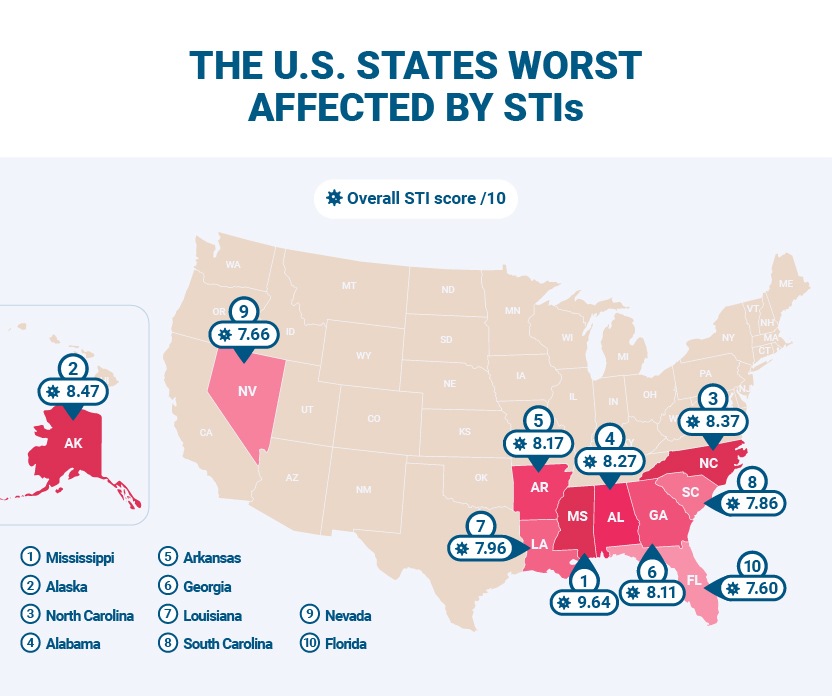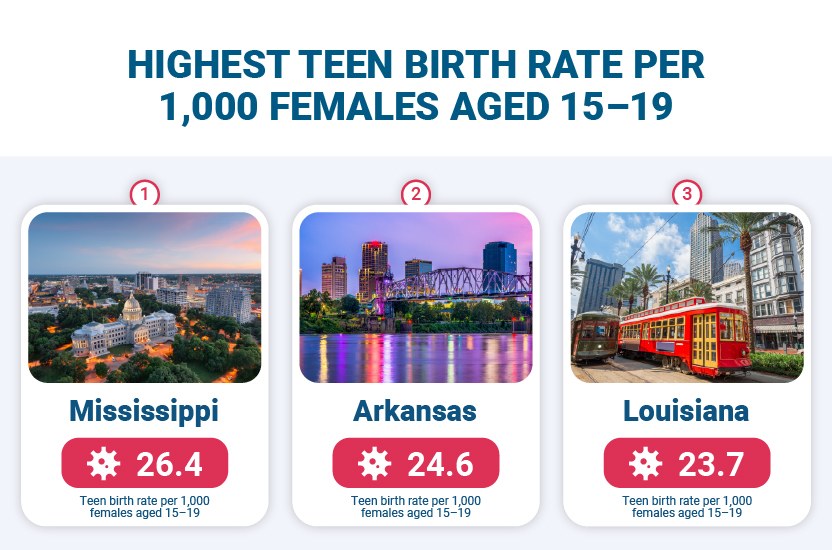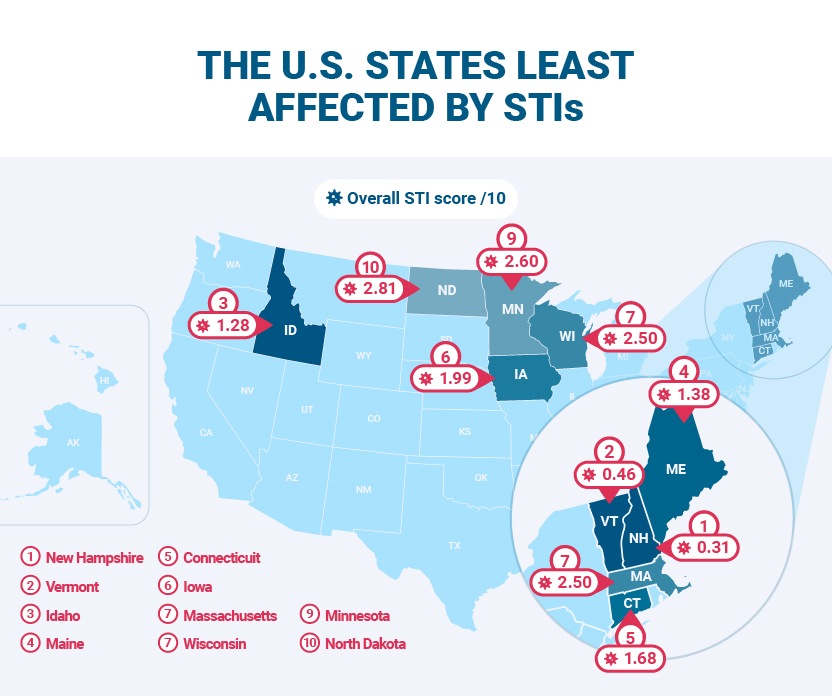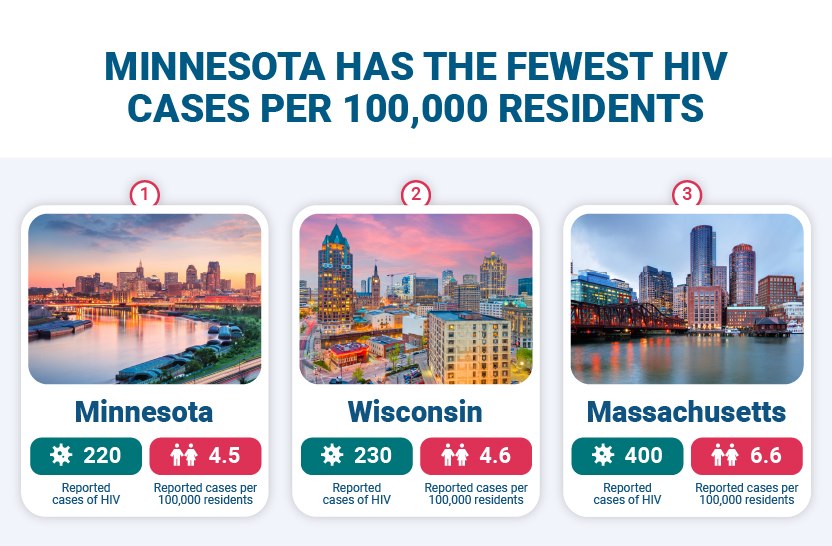Which U.S. states are most affected by STIs?
Sexually transmitted infections (STIs) can present a range of unpleasant symptoms, from unusual discharge to skin growths around the genital area. Unfortunately, STIs are more common than we would hope, with statistics indicating that one in five Americans have had an STI1.
While advancements in science over the decades have resulted in effective STI treatments in the form of prescription drugs, prevention is always the best option. But which U.S. states are currently the most affected by STIs, and which age groups are the biggest contributors? The following index reveals this information and more, alongside an expert commentary on the current state of sex education across America.
Key findings
- Reported cases of syphilis have spiked by more than 2,300% in South Dakota over the last five years.
- 86% of U.S. states have seen a reduction in chlamydia cases since 2019.
- When it comes to HPV, there is a 46.7% difference between the most vaccinated (Rhode Island) and least vaccinated U.S. state (Mississippi).
- Vermont is the only U.S. state to have seen a reduction in syphilis cases in the last five years.
- HIV cases have decreased by 13.5% since 2018 — more than any other STI in the U.S.
The U.S. states worst affected by STIs


-
Mississippi - STI score of 9.64 out of 10
With a score of 9.64 out of 10, Mississippi is revealed as the U.S. state worst affected by STIs. This Southeastern state has some of the highest reported cases of chlamydia in the country, equating to more than 700 cases per 100,000 residents.Unfortunately for residents, this state also has the lowest HPV vaccination rate in the country (38.5%), which is more than 20% lower than the national average (62.6%).
-
Alaska - STI score of 8.47 out of 10
Alaska may not have a high number of reported STI cases compared to other states in America. Still, when the population is considered, this is one of the worst affected, particularly concerning gonorrhea, which stands at a rate of 251.1 per 100,000 residents.Alaska’s chlamydia rate (700.9 reported cases per 100,000 residents) is the state’s most prevalent, but it is worth noting that STI has reduced by more than 18% in the last five years, showing that this state is heading in the right direction.
- North Carolina - STI score of 8.37 out of 10
North Carolina completes this ranking as the third worst-affected U.S. state regarding STIs. This state has had over 65,867 cases of chlamydia, which equates to almost 608 per 100,000 people. However, this figure has reduced by 6.2% since 2019, when cases hit over 70,000.
U.S. states where HIV is most prevalent


- Georgia - 23.1 reported cases per 100,000 residents
Georgia’s HIV rate is 23.1 reported cases per 100,000 residents, which is more than double the national average of 11.8 cases per 100,000 residents. Georgia’s capital, Atlanta, has experienced a recent surge in HIV cases, but the city has been working hard to encourage prevention tools like pre-exposure prophylaxis (PrEP).
Despite having the highest HIV rate in the U.S. in 2022, this figure has dropped by more than 12% since 2018, which is a positive sign.
U.S. states where HIV cases have increased the most


- Arkansas - 66.7% increase in reported cases
There were 400 reports of new HIV cases in 2022, equating to 15.5 per 100,000 residents. While this figure isn’t as high as some other U.S. states, it has increased by over two-thirds since 2018. Unfortunately, these numbers are far from the U.S. average, as the country has seen 13.5% fewer HIV cases between 2018 and 2020.
U.S. states where Monkeypox is the most common


- New York - 20.8 cases per 100,000 residents
While Monkeypox isn’t classified as an STI, it can be transmitted through sex and/or kissing. There was a serious outbreak in 2022, with the U.S. declaring a Public Health Emergency (PHE) following 30,395 cases and 42 deaths throughout the nation.2
Of these reported cases of this infectious disease in the U.S. as of 2022, around 13% were reported in New York alone. While California had more reported Monkeypox cases during this time, New York had a higher rate when population is considered, totaling 20.8 cases per 100,000 residents.
Highest teen birth rate per 1,000 females aged 15–19


- Mississippi - 26.4 births per 1,000 females aged 15–19
When it comes to 15 to 19 year olds, Mississippi has the highest birth rate of any U.S. state, totaling 26.4 births per 1,000 females. The state of Mississippi does require schools to provide sex education to pupils, but the content is not required to cover contraception or consent3. With pupils not being required to learn about contraception, it may not come as a surprise that birth rates are so high among the population here.
The U.S. states least affected by STIs


-
New Hampshire - STI score of 0.31 out of 10
New Hampshire takes the top spot for the lowest STI rates in the U.S. It reports only 588 cases of gonorrhea (41.9 per 100,000 residents) and just 139 cases of syphilis (9.9 per 100,000). While the number of chlamydia reports is higher at nearly 197 for every 100,000 people, it is still the lowest in the United States.The state has one of the highest HPV vaccination rates at 76.2%, just behind Rhode Island and Massachusetts.
-
Vermont - STI score of 0.46 out of 10
Vermont is in second place, with almost 202 chlamydia cases per 100,000 people. The state has the lowest cases of both gonorrhea and syphilis out of the whole of the U.S., at 34 and 3.2 cases per 100,000, respectively.The number of gonorrhea and syphilis cases has been decreasing in the state since 2019, too. Syphilis reports went from 24 to 21, while gonorrhea reduced by almost 24% (from 1,718 to 1,307).
- Idaho - STI score of 1.28 out of 10
Idaho comes third but has noticeably higher rates for two infections. It reports the highest rates of syphilis and chlamydia, with 13.1 and 294.9 per 100,000. However, its rate of gonorrhea cases is slightly lower than New Hampshire, at almost 40 for every 100,000 residents.
Minnesota has the fewest HIV cases per 100,000 residents


- Minnesota - 4.5 reported cases per 100,000 residents
2022 saw Minnesota with the fewest number of reported HIV cases in the U.S., totaling less than 5 per 100,000 residents. This state also experienced one of the biggest reductions in new HIV cases between 2018-2022 (31.3%). Minnesota aims to reduce these numbers even further in the near future through a combination of education and awareness, reduced stigma, and sustainable resources.
New Hampshire records the lowest teen birth rate per 1,000


- New Hampshire - 4.6 births per 1,000 females aged 15–19
As well as being revealed as the U.S. state with the most positive overall score regarding STIs, New Hampshire was home to the lowest birth rate for teens aged 15–19 in 2022. This state’s high socioeconomic status and good access to healthcare are potential factors contributing to its low 4.6 birth rate per 1,000 females in this age group.
The age groups where STIs are most prevalent in the U.S.


The most commonly reported STI in America, chlamydia, is most prevalent among the 20–24 age group. While chlamydia rates are lower among those aged 65 and over, there has been a rise in the number of divorced seniors having unprotected sex in recent years. As a result, this age group has seen a 36% increase in chlamydia cases between 2019 and 2023.
Unfortunately, the 20 to 24 age bracket has also seen more newly reported cases than any other with regard to gonorrhea (142,526). Followed by 25–29-year-olds (113,774) and 30–34-year-olds (96,504), it is unsurprising that this sex-related bacterial infection is most prevalent across ages known for having a higher sex drive.
The most common age for those reporting new syphilis cases in the U.S. is slightly higher than other STIs, at 30–34 years old. Within this age group, men have a much higher prevalence than their female counterparts, totaling 62 and 21.5 cases per 100,000 residents, respectively.
The importance of sex education in schools across America
Dr Jamie Winn PharmD, Medical Director at Universal Drugstore, said:
“As of 2024, more than a quarter of U.S. states are not required to provide students with any kind of sex and HIV education3, and even fewer require that this education be medically accurate. With such rampant STI rates across the country, especially among young adults, it is now more critical than ever that they are aware of the risks surrounding unsafe sex and can make informed decisions around the topic.
“From contraception to consent and everything in between, sex education is a complicated yet vital subject. But whether it’s taught or not varies, depending on the school. In the schools where practicing safe sex and the associated risks are taught, future generations will be equipped with a greater understanding about STIs. Not only this, but they will also be better prepared to look out for the associated signs and symptoms should they contract a sexually transmitted infection so they can seek medical advice and treatment.
“The majority of U.S. states require that abstinence should be stressed to young people. While it is true that abstinence is the only 100% effective way to prevent teen pregnancy and STIs, teenagers are notoriously experimental, so it is careless to think that this form of sex education alone will make a positive difference. Having access to a comprehensive sex education curriculum gives students the information they need to be safe if they choose to explore, aiding both personal development and mental well-being.”
Methodology
We used CDC to find the following information for each U.S. state:
- Reported cases of Gonorrhea, Syphilis, and Chlamydia in 2019 and 2023, and cases per 100,000 residents.
- Reported Gonorrhea, Syphilis, and Chlamydia cases in 2023 by age group.
- Reported cases of HIV in 2018 and 2022, and cases per 100,000 residents.
- Teen birth rate per 1,000 females aged 15-19 in 2022.
U.S. totals include cases reported by the District of Columbia.
We subtracted the reported cases of Gonorrhea in 2023 from the 2019 figure before dividing this by the 2019 figure to calculate the change in Gonorrhea cases. This calculation was repeated for Syphilis, Chlamydia, and HIV.
We used KFF to find the reported cases of Monkeypox as of 2022 and Census to find the population of each U.S. state as of 2022. We divided the number of reported Monkeypox cases by the population before multiplying this by 100,000 to find the number of cases per 100,000 residents in each U.S. state.
We used America’s Health Rankings to find the HPV vaccination rate for adolescents aged 13-17 as of 2022.
We used the STI-related factors (Gonorrhea, Syphilis, and Chlamydia cases per 100,000 residents and HPV vaccination rates) and normalized each factor out of 10 before taking an average of those scores to get our overall ‘STI score’.
Additional sources:
- https://www.cdc.gov/sti/php/communication-resources/prevalence-incidence-and-cost-estimates.html#:~:text=CDC%20estimates%20indicate%20about%2020,billion%20in%20healthcare%20costs%20alone.
- https://www.kff.org/global-health-policy/issue-brief/mpox-one-year-later-where-is-the-u-s-today/
- https://www.guttmacher.org/state-policy/explore/sex-and-hiv-education#:~:text=38%20states%20and%20the%20District,states%20only%20mandate%20sex%20education.






